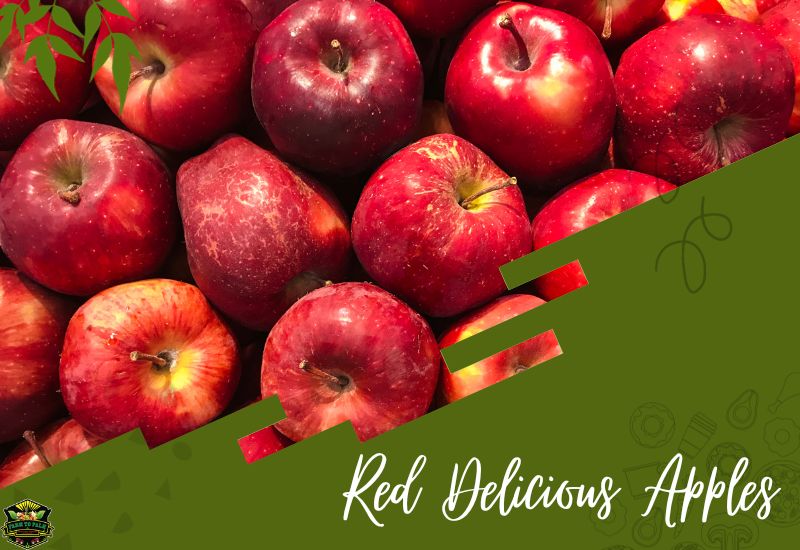Red Delicious apples are renowned and often considered the quintessential American red apple. Despite criticism about their flavor, their intriguing history compensates for perceived blandness. In this article, you will discover everything about Red Delicious apples, including the most nutrition information and their fascinating origin.
Fun Facts About Red Delicious Apples

Several well-liked modern apple varieties owe their origin to the Red Delicious apple. For instance, the world’s sweetest apple, the Fuji, springs from a cross between the Red Delicious and Rawls Janet. The Empire apple, a mix of Red Delicious and McIntosh, is rising in U.S. popularity.
There’s an intriguing tale behind the naming of Red Delicious. Legend has it that Clarence Stark exclaimed “Delicious!” upon tasting the apple, and this spontaneous expression of joy became its name. As the vibrant color grew significantly, the apples were eventually dubbed Red Delicious.
Interestingly, the discovery of Red Delicious apples was part of a competition to find a superior substitute for the Ben Davis apple, once the top-selling apple before the late 1800s. Consumers had begun grumbling about the lackluster taste of Ben Davis apples, prompting the search for a tastier alternative. In an ironic twist, some consumers now opine that Red Delicious apples are somewhat bland!
Red Delicious Apple Nutrition Information
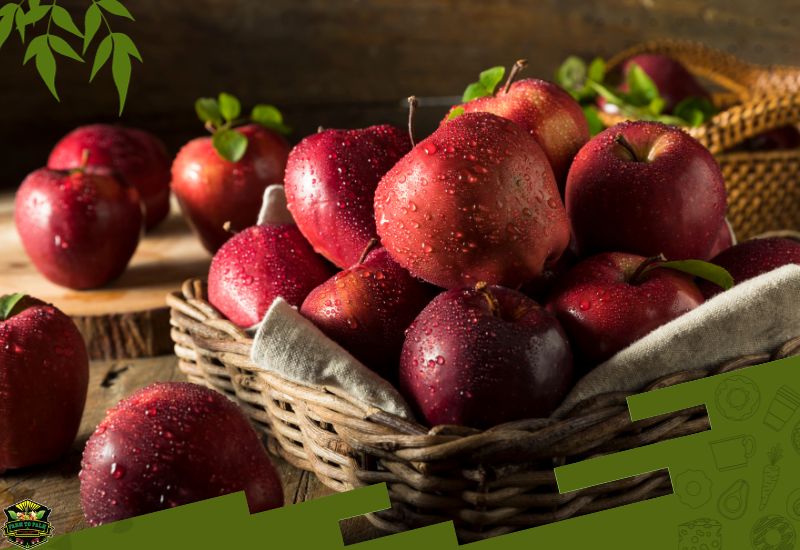
Red Delicious apples are a multipurpose health powerhouse. They’re packed with vitamin C, essential for bolstering your immune system, and fiber, which keeps your digestive system running smoothly. They also contain potassium, a crucial mineral that helps balance your body’s fluid levels.
For optimal organ function, these apples supply vitamin A. They also offer vitamin E, known for its powerful inflammation-fighting properties. Vitamin K found in this variety supports the creation of bone tissue, while calcium contributes to robust teeth and bones.
But that’s not all; Red Delicious apples also provide other beneficial nutrients like magnesium, boron, copper, iron, zinc, and phosphorus. The vibrant red skin of these apples hints at anthocyanins – pigmented compounds that work like antioxidants, protecting your cells from damage and oxidative stress due to harmful free radicals.
So, when you reach for a Red Delicious apple, you’re not just getting a tasty snack—you’re investing in your health and wellbeing.
| Nutrient | Amount | % Daily Value (DV) |
|---|---|---|
| Serving Size | 1 medium (212g) | – |
| Calories | 125 | – |
| Total Fat | 0.42g | 1% |
| Saturated Fat | –g | –% |
| Trans Fat | 0g | – |
| Cholesterol | –mg | –% |
| Sodium | 2.1mg | 0% |
| Total Carbohydrate | 29.8g | 11% |
| Dietary Fiber | 4.9g | 17% |
| Total Sugars | 22.2g | 44% |
| Includes –g Added Sugars | –% | – |
| Protein | 0.57g | 1% |
| Vitamin C | –mg | –% |
| Vitamin D | –mcg | –% |
| Iron | 0.23mg | 1% |
| Calcium | 12.7mg | 1% |
| Potassium | 220.5mg | 5% |
| Phosphorus | 25.4mg | 2% |
The % Daily Value (DV) tells you how much a nutrient in a serving of food contributes to a daily diet. 2,000 calories a day is used for general nutrition advice.
What do Red Delicious Apples taste like?
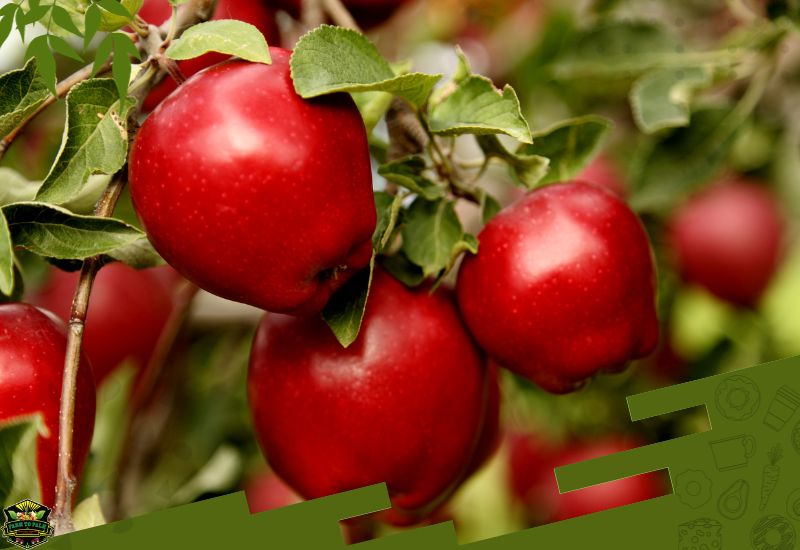
Red Delicious apples are medium to large, measuring 6-8 centimeters in diameter. Their shape is conical, broad, and flat at the top, tapering to a narrow, pointed base. Over time, they have been bred from a heart-like shape to their current form. The base of the apple features five unique bumps. The stems can vary in color from green to brown and have a slender, fibrous texture.
The skin of the Red Delicious apple is thick and chewy with a smooth, shiny finish, often coated in wax. It’s primarily golden yellow but overlaid with a dark red to-crimson blush. Small pale spots or lenticels are also discernable on the surface. While these apples are known for their deep red color now, they originally had a bi-colored, striped appearance.
Beneath the skin lies the ivory-to-pale yellow flesh. It’s fine-grained, water-rich, and soft yet crisp. Encased within it is a medium-sized core housing black-brown, teardrop-shaped seeds. The texture of the flesh can become mealy depending on how it’s grown and its age.
Red Delicious apples are perfect for raw consumption with their refreshing, mildly sweet flavor. Their taste is subtle and neutral, sometimes carrying slight melon-like undertones.
Where are Red Delicious Apples grown?
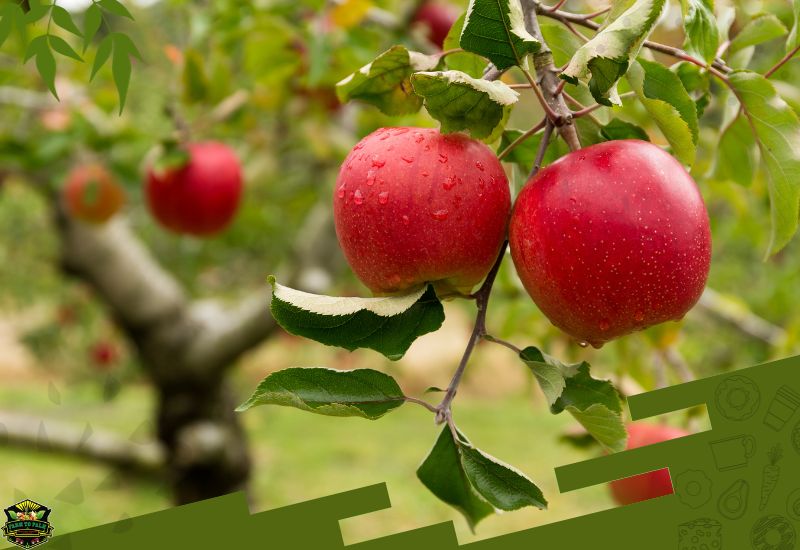
The origin story of the Red Delicious Apple variety traces back to the 1870s on a farm in Peru, Iowa, owned by Jesse Hiatt. Initially seen as a pesky seedling, Jesse attempted to remove it multiple times, only for the resilient tree to bounce back. On its third comeback, Jesse let the tree grow and bear apples.
Jesse’s apple, named the “Hawkeye,” was presented at a Missouri fruit show in 1893. Impressed, the Stark Brothers Nursery bought the rights to commercialize the apple, rebranding it as the “Stark Delicious.”
In 1914, the apple was renamed “Red Delicious” to avoid mixing with another variety—the “Golden Delicious,” also promoted by Stark Nurseries.
Renowned for its vibrant and deep crimson hue, mild sweetness, and freshness, the Red Delicious Apple embodies what an iconic American red apple should be.
Ideal for fresh consumption due to its tender flesh that doesn’t fare well in cooking, the Red Delicious Apple also boasts a higher antioxidant content than many other apple varieties, thanks to its intense red skin. This makes it not just tasty but also a healthy choice.
When are Red Delicious Apples in season?
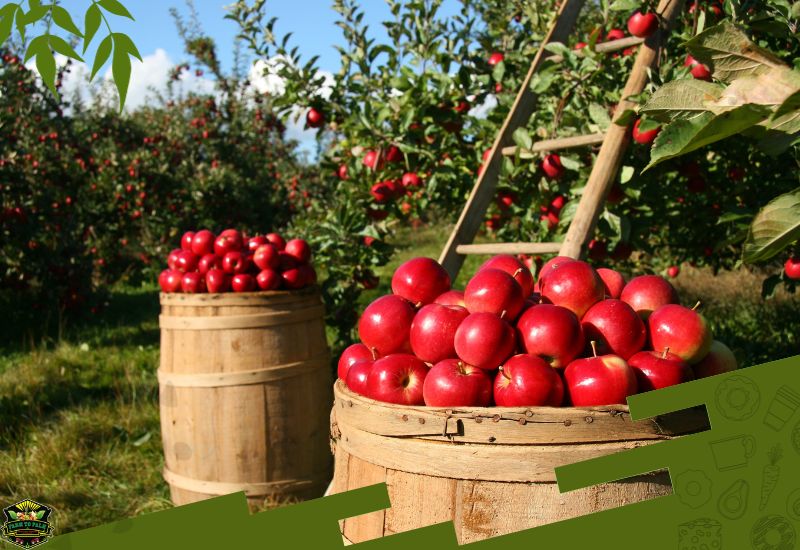
The harvesting period of “Red Delicious” apples can vary, influenced by geographical location and prevailing weather conditions.
Typically, apple harvest season spans from July to October, with “Red Delicious” usually ready for picking in the mid to late part of this duration.
For home gardeners growing these apples, a helpful way to predict their ripeness is by monitoring the bloom times of the trees.
After the “Red Delicious” trees are in full bloom, it usually takes 135 to 155 days for the apples to mature. This timeframe could be more precise but provides a beneficial guideline for knowing when to start checking your apples for readiness.
What to make with Red Delicious Apples?

Red Delicious apples, with their mild and subtly sweet flavor, are perfect for various fresh preparations. Their taste is best savored when eaten fresh, although some may prefer to peel off the tough skin first. For the most delightful taste experience, serving these apples chilled is suggested.
Here are some ways you might want to enjoy Red Delicious apples:
- Handy Snack: These apples can be consumed as is, making for a refreshing and healthy snack.
- Salad Ingredient: Adding chopped pieces of Red Delicious apples to your salads can enhance the overall flavor.
- Slaw Addition: Shred them into slaws for a delightful crunch.
- Fruit Medleys and Grain Bowls: Mix them in fruit or grain bowls for a nutritious meal.
- Cheese Plate Companion: Serve them on cheese plates to complement the flavors.
- Toast Topping: Layer them on nut butter toast for a breakfast twist.
- Edible Garnish: Carve them into various shapes to use as an attractive edible garnish.
While fresh consumption is most common, Red Delicious apples can also be cooked, although they tend to become soft quickly. Here are some cooking suggestions:
- Apple Sauce: Simmer them into sauces for a sweet and tangy flavor.
- Soup Thickener: Use them as a thickener in soups for added texture.
- Apple Butter: Cook them into apple butter for a rich and creamy spread.
- Jams, Jellies, and Syrups: Incorporate them into jams, jellies, or syrups for a sweet addition to your breakfast table.
- Juices: Blend them into juices, adding a refreshing touch to your drink.
Red Delicious apples pair well with:
- Spices: Ginger, cinnamon, nutmeg, and cloves bring out the apple’s flavor.
- Cheeses: Parmesan, brie, gouda, feta, and goat cheese complement the apple’s sweetness.
- Fruits: Cherries, nectarines, peaches, and blueberries enhance the apple’s taste.
- Nuts: Almonds, pine nuts, and walnuts add a delightful crunch.
When stored in a cool, dry, dark place like a cellar or your refrigerator’s crisper drawer, whole and unwashed Red Delicious apples can last up to four months.
Health Benefits of Red Belicious Apples

For Digestive Health:
Apples are high in fiber, including a soluble fiber called pectin, which improves digestion. Pectin can reduce diarrhea-causing bacteria and add bulk to stools, relieving diarrhea. Apple skin contains an insoluble fiber called cellulose that aids in efficient digestion and relieves constipation.
Improve Brain Health:
Research suggests that consuming apples can improve brain health and lower the risk of diseases like Alzheimer’s and Parkinson’s. The antioxidant quercetin in apple skin reduces oxidative stress by blocking harmful free radicals that can damage brain cells.
Better Skin & Youthful Looks:
Apples contain vitamin C, which helps produce collagen, a protein crucial for healthy skin. Collagen maintains the skin’s waterproof barrier, improving complexion and radiance. Vitamin C also strengthens hair and nails.
Strengthen Your Immune System:
Apples are rich in vitamin C and antioxidants that boost immunity. Quercetin, an antioxidant in red apples, fortifies the immune system, especially during stress. The soluble fiber in apples reduces inflammation and strengthens immunity.
Improve Eye Health:
Apples contain vitamins C and A, promoting healthy eyes by preventing fatigue, dryness, and night blindness. These vitamins also remove free radicals that contribute to cataract formation. Long-term studies show that consuming antioxidant-rich fruits like apples reduces the risk of cataracts.
Reduce the Risk of Heart Disease and strokes:
Regular apple consumption reduces LDL (bad) cholesterol levels and inflammation in artery walls, lowering the risk of heart disease. Studies also show a strong correlation between higher apple intake over time and a lower risk of stroke. Increasing dietary fiber intake by 7 grams, equivalent to one large apple, reduces the risk of a first-time stroke.
May Help Combat Diabetes:
Although carbs can raise blood sugar levels, the carbs in apples differ from those in junk food. Apples contain healthy fiber that protects against type 2 diabetes and improves blood sugar control. Regular apple consumption also reduces insulin resistance, lowering blood sugar levels.
Reduce the Risk of Cancer:
The dietary fiber in apples helps reduce cancer risk by promoting weight loss and increasing feelings of fullness. Flavonoids such as quercetin, triterpenoids, and pectin protect against colon, lung, and breast cancers at various stages of development.
Weight Loss & Lower the Risk of Obesity:
Soluble fiber, found in abundance in apples, aids weight loss by slowing digestion and increasing satiety. Apples also contain ursolic acid, which can increase calorie burn by boosting brown fat production, helping combat obesity.
For Healthier Bones:
Phloridzin, a unique phytonutrient in apple skin, improves bone density and reduces bone breakdown, especially in postmenopausal women. Apples are also a natural source of boron, a mineral crucial for strengthening bones and reducing osteoporosis risk.
For Healthier Teeth:
Apples act as a natural toothbrush due to their fiber and thick skin, reducing plaque build-up and protecting teeth and gums. Eating an apple stimulates saliva production, which rinses away bacteria and food particles.
Detoxify Your Liver:
Apple peel contains ursolic acid, which partially protects against fatty liver disease. Additionally, apples are rich in pectin and malic acid, which cleanse the blood by removing toxins, cholesterol, and carcinogens, promoting a healthier liver.
Lower the Risk of Asthma:
Consuming apples during pregnancy may reduce the risk of asthma and wheezing in children. A study found that women who regularly ate apples during pregnancy had children less prone to asthma or wheezing by age 5 than those who rarely consumed apples during pregnancy.
Provide Protection Against Nonsteroidal Anti-Inflammatory Drugs (NSAIDs):
Polyphenols in apple peel can help prevent or treat side effects caused by NSAIDs and painkillers that can harm the stomach lining. Chlorogenic acid and catechin in apples also reduce damage to the stomach lining from these drugs.
Difference between Gala Apples vs Red Delicious Apples
| Characteristics | Red Delicious Apple | Gala Apple |
|---|---|---|
| Appearance and Color | Deep red skin, often shiny and smooth. Can vary from bright crimson to darker maroon hue. | Yellow to orange-red skin with a blush of pink or red stripes. Attractive and inviting appearance. |
| Size and Shape | Medium to large, round or slightly elongated form, symmetrical and well-proportioned. | Generally smaller, medium-sized with a round shape and slightly flattened bottom. Easy to hold and consume. |
| Taste and Texture | Mildly sweet flavor with a hint of tartness. Firm and dense texture, providing a satisfying crunch. | Sweeter taste compared to Red Delicious. Crisp and juicy texture, slightly softer than Red Delicious. Ideal for raw consumption and softer apple recipes. |
| Origin and History | Discovered in the late 1800s in Iowa, United States. Popular for attractive appearance and sweet flavor. | Developed in New Zealand in the 1930s. Cross between Kidd’s Orange Red and Golden Delicious varieties. Gained rapid popularity for unique flavor and appealing appearance. |
| Nutritional Comparison | Similar calorie content: Red Delicious – about 95 calories, Gala – around 80 calories. Red Delicious has higher vitamin C content, while Gala is rich in potassium. Both offer small amounts of other vitamins and minerals. Red Delicious has slightly higher fiber content. Gala has a good balance of sweetness and slight tartness. | Both varieties are low in calories and fat, primarily composed of carbohydrates (natural sugars). Red Delicious has higher vitamin C content, Gala is rich in potassium. Both offer small amounts of other vitamins and minerals. Red Delicious has slightly higher fiber content. |
| Culinary Uses | Great for raw consumption, salads, or pairing with cheese. Holds up well in cooked preparations. | Suitable for raw consumption, fruit salads, applesauce, or apple butter due to its tender texture. Adds sweetness and flavor to baked goods such as pies and muffins. |
| Shelf Life and Storage | Store in the refrigerator’s crisper drawer, separate from other fruits and vegetables. Use breathable containers like mesh bags or perforated plastic bags. Keep away from strong odors. | Store in the refrigerator’s crisper drawer, separate from other fruits and vegetables. Use perforated plastic bags or airtight containers to maintain moisture and crispness. Keep away from strong odors. |
| Availability and Seasonality | Harvested in late summer to early fall (September to October). Widely available in the United States and other countries. | Harvested slightly earlier (late summer to early fall – August to September). Widely cultivated worldwide, making them more accessible throughout the year. |
| Environmental Impact | Pesticide use can vary depending on farming practices (conventional vs organic). Sustainable farming practices help minimize environmental impact. Consider carbon footprint and support locally grown or organic options when possible. | Pesticide use can vary depending on farming practices (conventional vs organic). Sustainable farming practices help minimize environmental impact. Consider carbon footprint and support locally grown or organic options when possible. |
| Average Retail Prices | Generally lower price compared to Gala apples. Can vary depending on region, season, and availability. | Generally slightly higher price compared to Red Delicious apples due to higher demand. Can vary depending on region, season, and availability. |
| Value for Money | Offers good value with its attractive appearance, mildly sweet flavor, and firm texture for a satisfying crunch. Versatile for both raw consumption and cooked preparations. | Offers good value with its attractive appearance, sweet flavor, and crisp texture for a refreshing eating experience. Versatile for raw consumption, fruit salads, or baked goods. |
Where to buy Red Delicious Apples?
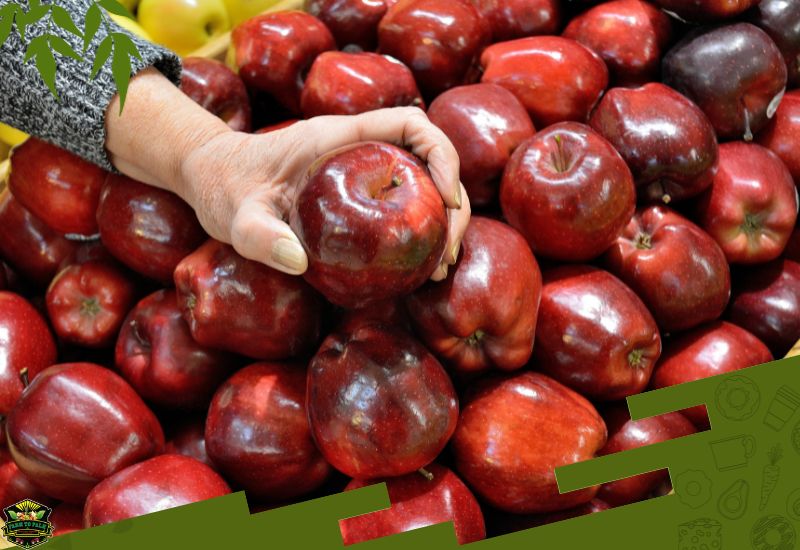
You have a few options if you’re looking to buy Red Delicious apples. You can visit supermarket or grocery store and head to the produce section.
Red Delicious apples are widely available, so you should be able to find them there quickly. Alternatively, you can conveniently order Red Delicious apples from the Farm to Palm app store.
Search for “Red Delicious apples” in the app and place your order. Whether you shop at a physical store or through the app, you’ll enjoy the delightful taste and numerous health benefits of these iconic American red apples.

